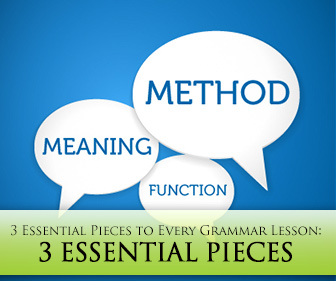You come into grammar class full of excitement and enthusiasm.
You present your students with the day’s lesson, and clearly explain how to form the future progressive tense. They seem to understand, can do the exercises and don’t ask any difficult questions. They must have it, right? So why don’t they use the future progressive correctly in the days to come? It’s because a good grammar lesson includes more than just how to put words together. Without knowing how to form a grammatical structure, what it means and how to use it, your student’s won’t be getting all the grammar they need.

3 Essential Pieces to Every Grammar Lesson
-
1
Method
The first piece you need for every grammar lesson is probably the most obvious. Your students need to know how to do something, how to form a tense, what helping verb to use, what elements are necessary for a clause. This is method. This is the rule of grammar. If you were teaching a lesson on the future progressive, for example, you would explain to your students how to create that grammatical form. You would show them how to combine the subject of the sentence with the future form of the helping verb be and the progressive form or second form of the verb. This combination Subject + be(fut) + V(2nd form) = the future progressive tense. Your students can now form this tense with any subject and any verb you give them. But that is not enough. They need to know what this tense means.
-
2
Meaning
Knowing how to create a particular grammatical structure will only take you so far if you do not know what it means. After all, language is a way to express the ideas and mental images in our minds. Without the meaning, we have nothing. Method without meaning is like memorizing a math equation without understanding what it does. (How many people really know the meaning behind the equation e=mc2?) For the future progressive example, your students need to understand that the future progressive is used for actions that will be in progress at some future time. They need to know what an action in progress entails. They need to understand what a future time might be. When they understand the meaning of the future progressive tense, they can create a mental image of an action happening in the future and being interrupted by another action.
-
3
Function
Once your students are comfortable creating the form and know what that form means, it is time to talk about function. In grammatical terms, the function is what the target structure is for. Why do we use that particular grammatical structure? This third piece of the grammar lesson would show students that the future progressive tense is used to talk about an event that will be in progress in the future. That that event may or may not have already started at the present moment. That it may or may not continue after that point in the future. Your students will understand that the function of the future progressive is to describe a scene and what is happening at a point of time in the future – whether that point in time is an actual moment or another event is irrelevant.
When your students understand what to do for a specific structure, what that structure means and when to use it, they will have full understanding of the grammatical concept you are teaching.
All three pieces of information are necessary if your students are to be successful language learners. If any of the three is missing, you will see that your students will not know why they should use a particular structure or what it means when they do, or they won’t understand what they mean even when they can follow the correct grammatical formula. For most teachers, teaching the how or form of grammar is obvious. Teaching the meaning and the function may not come through as clearly. That’s why the best grammar teachers make a point to spend time teaching all three pieces in every grammar lesson. When you spend equal time teaching method, meaning and function, your students will know not only what to do, but why to do it and how. And when they know that, they will be better language learners and speakers all around.
P.S. If you enjoyed this article, please help spread it by clicking one of those sharing buttons below. And if you are interested in more, you should follow our Facebook page where we share more about creative, non-boring ways to teach English.







